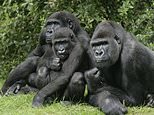Gay behaviour is the norm for most animals: Scientists study homosexual acts in 1,500 species – and say same-sex displays evolved repeatedly to increase social bonding and reduce conflict
>
Homosexuality in nature seems counterintuitive but is observed in a range of species around the world.
There is still no accepted explanation based on neural, chemical or behavioral factors to explain why some animals are homosexual and others are heterosexual.
Some scientists say it may be due to exposure to testosterone levels in the womb, although this is still a hotly debated topic and has not yet been proven.
In a book titled: “Homosexual Behavior in Animals: An Evolutionary Perspective,” the author, University College London professor Dr. Volker Sommer, writes: “Within a select number of species, homosexual activity is widespread and occurs at levels approaching or sometimes exceeding heterosexuality.” “. activity.’
Homosexual behavior has been observed in many animals, including: macaques, dwarf chimpanzees, dolphins, orcas and humans.
Some studies claim that homosexuality may be common, being found in up to 95% of all animal species.
There are two basic schools of thought when it comes to the prevalence of homosexuality in nature.
One theory states that homosexuality in animals is self-explanatory, as animals are naturally homosexual as well as heterosexual.
It seems counterintuitive to have survival as a trait because it directly impedes the ability to reproduce, but many speculate that it allows individuals to ensure that their genetic material is passed down through generations indirectly because they are able to care for their family members along with their offspring.
For example, helping raise a sister’s offspring.
Similar behavior dedicated to the “common good” of a large group has been seen in various species.
For example, in family wolf packs, only one pair of animals is bred – alpha and beta. Other animals provide protection, nourishment and care for the litter.
This allows their genetic material to be passed indirectly to the next generation through their sister, brother, mother, etc., or whatever the relationship may be.
The same school applies to animals past reproductive age.
For example, female elephants that are now too old to produce offspring.
They still play a crucial role in protecting the young, with the mother leading the group to places of food and water and chasing away potential predators.
These measures ensure the survival of her young and weak family members, again helping to ensure that her genetic material is indirectly passed down through the generations.
Some experts claim that a similar concept could be applied to homosexuality.
Without the ability to reproduce directly, they are able to spend energy caring for the offspring of their family members.
Another theory states that homosexual behaviors aid in successful long-term gene passing when young animals practice mating techniques and methods of attracting a member of the opposite sex.
Rates of homosexuality in different species are still unknown, with ongoing research finding more nuances to homosexuality in nature.
It is still found in more species, but the level of homosexuality in individual species has not been studied well enough for us to be able to determine whether homosexuality is becoming increasingly common.
(Tags for translation) Daily Mail
